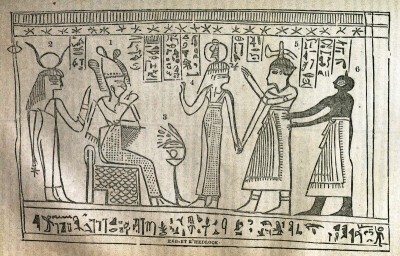Shulem wrote: ↑Mon Sep 20, 2021 8:15 pm
Jeff,
The Book of Abraham text directly states that the sacrifices mentioned therein were performed in the land of Chaldea on an altar designed specifically for human sacrifice. The
plain of Olishem was designated as the place where the sacrifices of Egyptian custom took place. But there is a problem with the narrative of the text (Abraham 1:10) and the vignette of Facsimile No. 1 which provides Abraham’s own illustration of the Abrahamic sacrifice mentioned in the text of verse 12. They do not agree. There are clear contradictions between Olishem being yonder in another quarter of land outside of Egypt and the location designated in the iconographic symbolism of Facsimile No. 1 of
“Abraham in Egypt” according to Facsimile No. 1, Fig. 10.
I would like to discuss those differences with you, Jeff. I think it can be shown that Smith’s narrative in the text does not match the iconographic symbolism of the vignette in which he attempted to connect to his story in the Book of Abraham.
Has this ever raised any level of concern with you, Jeff?
Sincerely,
Shulem
Jeff,
With regard to the location of the alleged sacrificial ritual performed by Egyptians against Abraham’s life in Chaldea, specifically on the
“plain of Olishem”, there is a clear and marked difference between the text of the Book of Abraham and the iconic representation of Facsimile No. 1. It’s rather very simple, thus, the text placed the scene in a foreign land and the Facsimile is indigenous to Egypt proper. The contradictory accounts places one scene in the northern Levant and the other in the very land of Egypt. Thus, the text says the sacrifice occurred in Chaldea but the representation shows it happening inside Egypt. Both can’t right.
Please note the following characteristics that are specific to the so-called sacrifice scene of Facsimile No. 1, described by Joseph Smith, as it compares to the iconic representation of Osiris rising forth in resurrection:
1. Osiris is over the lion bed.
2. Lion bed is under Osiris.
3. Lion bed is over the Four Sons of Horus
4. Four Sons of Horus are under the lion bed
5. Four Sons of Horus are located by the Nile river
6. Nile river is located by the Four Sons of Horus
7. Crocodile is in the Nile river
8. Nile River hosts the crocodile.
9. Temple walls are near the Nile river
10. Nile river is near the temple walls
That is the geographic message of the vignette of Facsimile No.1.
Facsimile No. 1, Fig. 10, consists of a libation stand decorated with flowers typical to a funerary scene with sacred rituals being performed. Those flowers are placed to honor and commemorate the rising of Osiris on the lion bed. You’ll agree that it’s inconceivable to think that beautiful flowers are used to decorate an execution scene where somebody is being brutally murdered because they refused to worship the gods of another religion. The only thing Smith got right about Facsimile No.1 Fig 10, was that the scene is “in Egypt”. The vignette is an Egyptian scene being held
*in Egypt*.
Please consider Fig. 11, the base of the drawing and the foundation upon which the site is geographically located, this is represented as temple-like walls or a palace façade made of brick or stone. It’s adjacent to the Nile river and the crocodile that lives in the river. The scene is in Egypt. The Egyptian artist was mindful of proximity and convention using art to show the importance and placement of each particular layer or concept. The building is near the Nile, the Nile hosts the crocodile, the crocodile is near the lion bed where Osiris is rising. Proximity and geographic design is important to the message.
Egyptologist Robert Ritner gives an excellent summation of fig. 11, in
Part 1, advance forward to the 1:46:00 mark. Ritner explains that the series of rectangular shapes represent a niched bricking motif, a standard feature of Egyptian design that goes back to early Egypt and has interconnections between Egypt and Sumer brick architecture and is used as a baseline in design for Egyptian art.
Everything Smith said about Facsimile No.1, from top to bottom, was essentially false. The text of the Book of Abraham attempts to take the scene out of Egypt to some fantasized place in Chaldea called “Olishem”. That too is wrong. The Facsimile Explanations and the site or location as told in the story of the Book of Abraham is wrong. John Gee can search for the plain of Olishem for the rest of his life but he will never find it!
It’s clear to me, that the libation stand dressed with flowers and pots is
*IN* Egypt right next to the very lion bed in which Osiris rose from the dead. Do you agree?

